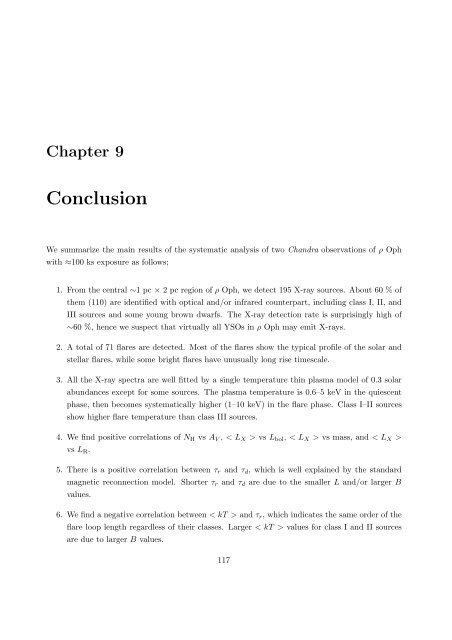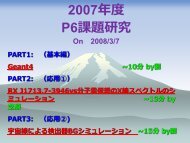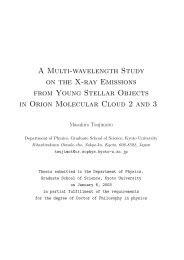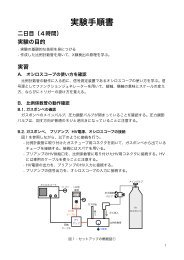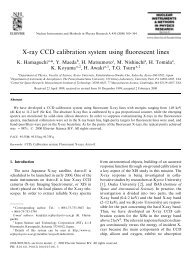X-ray Study of Low-mass Young Stellar Objects in the ρ Ophiuchi ...
X-ray Study of Low-mass Young Stellar Objects in the ρ Ophiuchi ...
X-ray Study of Low-mass Young Stellar Objects in the ρ Ophiuchi ...
Create successful ePaper yourself
Turn your PDF publications into a flip-book with our unique Google optimized e-Paper software.
Chapter 9ConclusionWe summarize <strong>the</strong> ma<strong>in</strong> results <strong>of</strong> <strong>the</strong> systematic analysis <strong>of</strong> two Chandra observations <strong>of</strong> <strong>ρ</strong> Ophwith ≈100 ks exposure as follows;1. From <strong>the</strong> central ∼1 pc × 2 pc region <strong>of</strong> <strong>ρ</strong> Oph, we detect 195 X-<strong>ray</strong> sources. About 60 % <strong>of</strong><strong>the</strong>m (110) are identified with optical and/or <strong>in</strong>frared counterpart, <strong>in</strong>clud<strong>in</strong>g class I, II, andIII sources and some young brown dwarfs. The X-<strong>ray</strong> detection rate is surpris<strong>in</strong>gly high <strong>of</strong>∼60 %, hence we suspect that virtually all YSOs <strong>in</strong> <strong>ρ</strong> Oph may emit X-<strong>ray</strong>s.2. A total <strong>of</strong> 71 flares are detected. Most <strong>of</strong> <strong>the</strong> flares show <strong>the</strong> typical pr<strong>of</strong>ile <strong>of</strong> <strong>the</strong> solar andstellar flares, while some bright flares have unusually long rise timescale.3. All <strong>the</strong> X-<strong>ray</strong> spectra are well fitted by a s<strong>in</strong>gle temperature th<strong>in</strong> plasma model <strong>of</strong> 0.3 solarabundances except for some sources. The plasma temperature is 0.6–5 keV <strong>in</strong> <strong>the</strong> quiescentphase, <strong>the</strong>n becomes systematically higher (1–10 keV) <strong>in</strong> <strong>the</strong> flare phase. Class I–II sourcesshow higher flare temperature than class III sources.4. We f<strong>in</strong>d positive correlations <strong>of</strong> N H vs A V , < L X > vs L bol , < L X > vs <strong>mass</strong>, and < L X >vs L R .5. There is a positive correlation between τ r and τ d , which is well expla<strong>in</strong>ed by <strong>the</strong> standardmagnetic reconnection model. Shorter τ r and τ d are due to <strong>the</strong> smaller L and/or larger Bvalues.6. We f<strong>in</strong>d a negative correlation between < kT > and τ r , which <strong>in</strong>dicates <strong>the</strong> same order <strong>of</strong> <strong>the</strong>flare loop length regardless <strong>of</strong> <strong>the</strong>ir classes. Larger < kT > values for class I and II sourcesare due to larger B values.117


